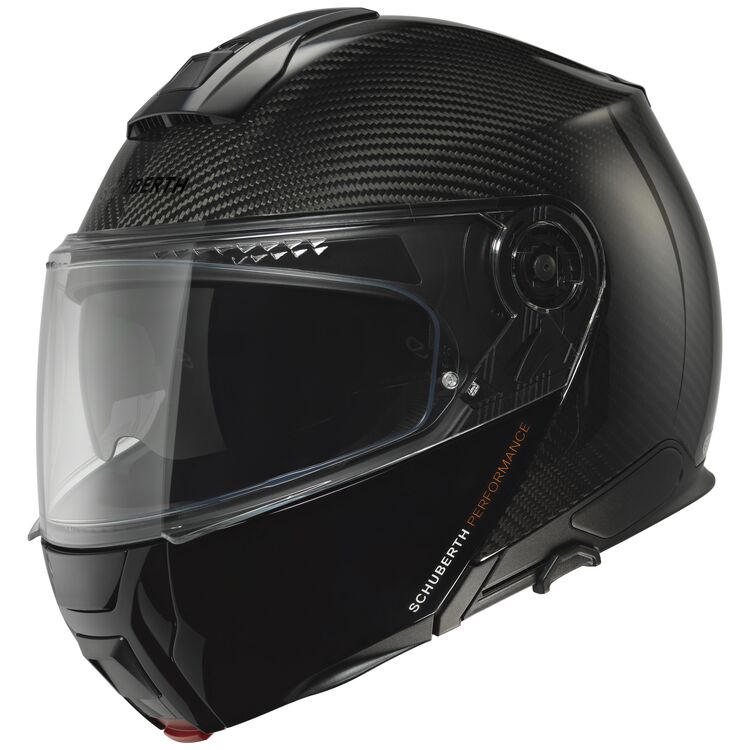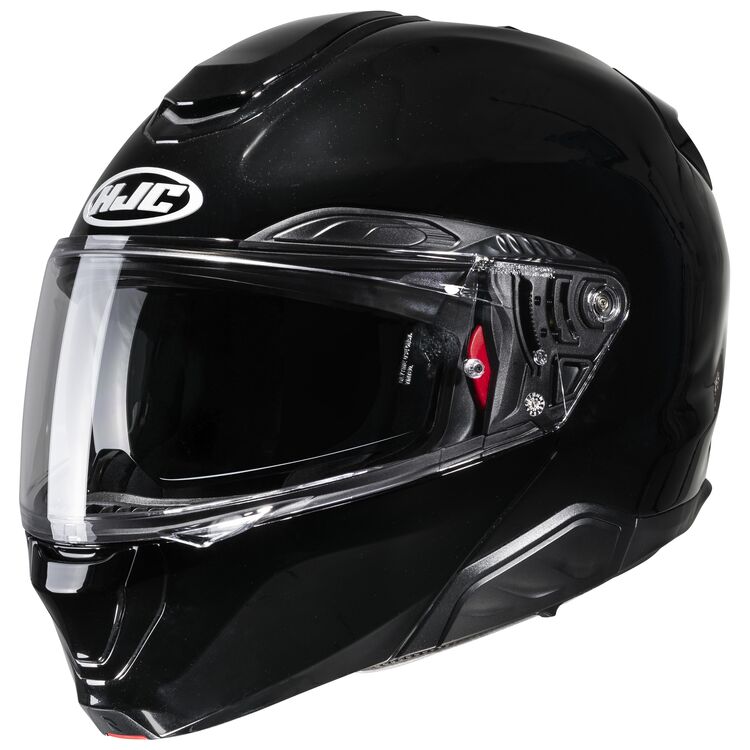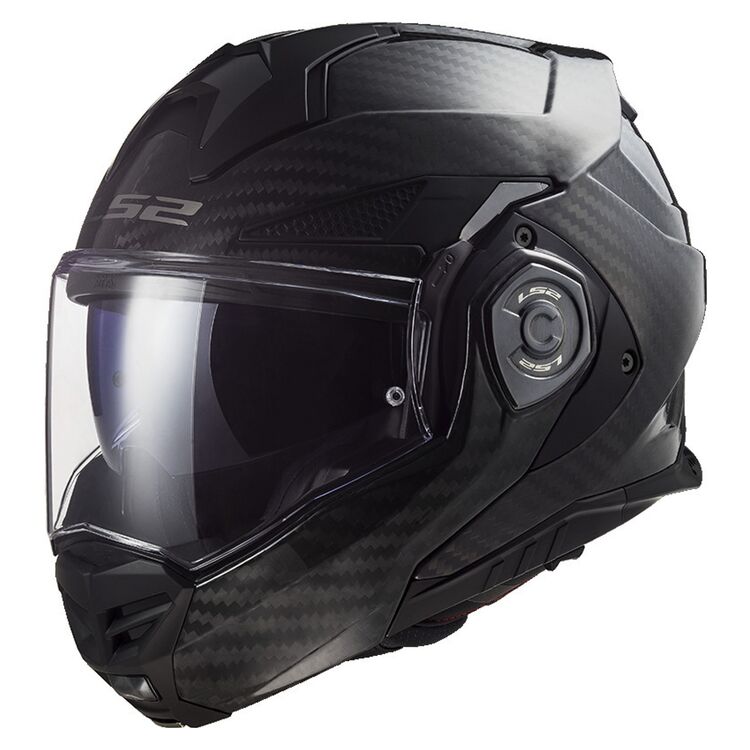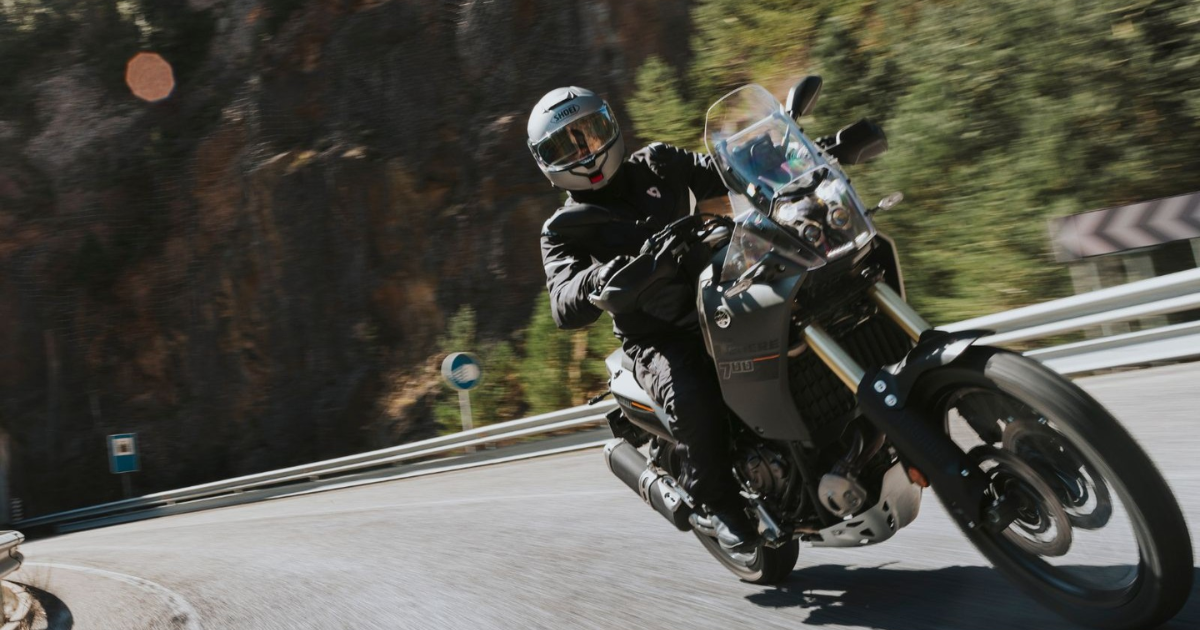
Lightest Modular Motorcycle Helmets for Every Rider
left for contents
Nothing wrecks a ride like a helmet that’s too heavy for your neck. Modular helmets are super convenient, but that extra mechanism also often comes with some extra weight. Modulars are typically heavier than full face helmets…
Yet there are exceptions — ultralight modulars that deliver comfort and safety without the weight penalty, and that’s what this guide is all about.
Here are our quick picks:
|
|
|
- At 1,640 g (3.61 lbs), it’s the lightest helmet in the lineup, which reduces neck fatigue on long rides.
- Schuberth is known for quiet helmets, and the C5’s aerodynamics + internal padding deliver excellent noise control.
- It comes with built-in speaker/mic slots for Sena’s SC2 system, so riders don’t need messy aftermarket installs.
- Weight is 1,720 g (3.79 lbs), keeping it light but still offering a very solid feel.
- Great field of view and optically-correct visor make it ideal for riders who value visibility.
- Aerodynamics and shell design are competitive with Shoei and Schuberth but often at a lower price point.
- At 1,780 g (3.92 lbs), it’s heavier than the other two, but still reasonable for a modular.
- Ventilation is surprisingly good for a helmet at its price.
- Consistently praised as a budget-friendly modular that still performs well on comfort and features.
Before we dive in to the reviews, here are a couple facts I’ve come to find true in my research and experience:
- A modular can be lighter than many full‑face lids. Helmets like the LS2 Advant X Carbon and Sedici Sistema 3 shave grams so aggressively that you’ll forget there’s a hinge at all.
- You don’t have to sacrifice quiet for convenience. The Schuberth C5 Carbon uses wind‑tunnel‑refined aerodynamics and a direct fiber shell to achieve 85 dB levels at highway speeds. That’s quieter than most full face helmets!
- Premium carbon modulars can cost as much as a small motorcycle, but budget options still deliver. From $200 polycarbonate lids to $1,500 carbon exotics, there’s a helmet here for every wallet.
- Your neck will thank you. Shaving half a pound off your helmet reduces fatigue on long rides; carbon modulars do exactly that.
Stick around and I’ll match you with the lightest modular that fits your riding style. Whether you’re a daily commuter, sport‑touring junkie or ADV explorer, there’s a flip‑up lid here that won’t feel like an anchor.
Which lightest modular helmet fits your ride?
Schuberth C5 Carbon — Touring serenity in carbon
Schuberth’s reputation for quietness and comfort is legendary among long‑distance riders. The C5 Carbon is the latest evolution of that legacy. It uses a single‑strand glass‑fiber shell created through direct fiber processing, which minimizes bulk while retaining strength. An integrated diffuser system along the neck roll and face shield reduces turbulence, resulting in internal noise levels around 85 dB. Slip this helmet on and the world seems to hush.
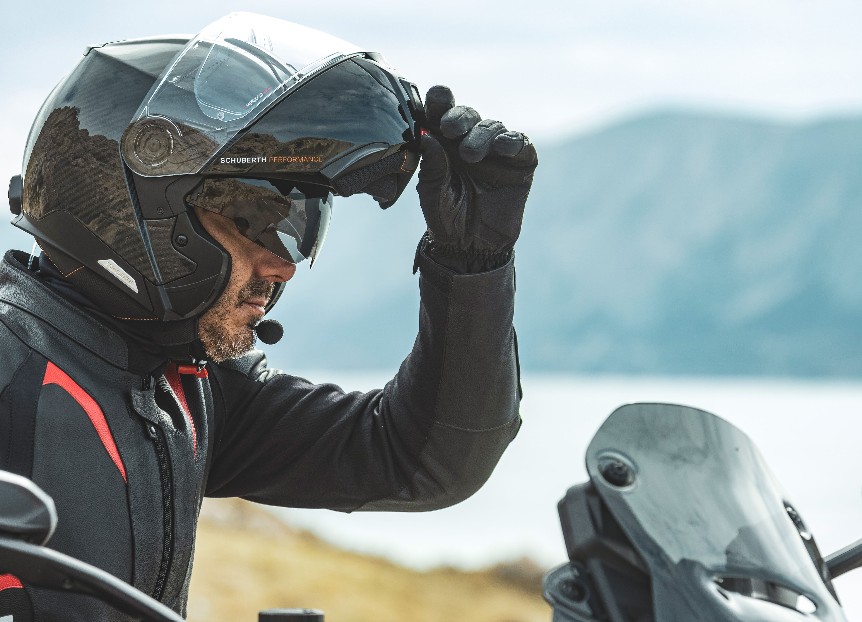
Schuberth includes speakers, microphone and antenna for the Sena SC2 comms unit inside the shell. That adds weight, but the carbon version still comes in around 3.21 lb. Ultimate Motorcycling measured a size‑large C5 Carbon with comms installed at 3.66 lb, about 6.7 oz lighter than the standard C5. On multi‑day tours through mountain ranges riders noticed less neck fatigue compared to heavier modulars. The aerodynamic profile feels planted in crosswinds, and the visor locks securely yet flips up easily at gas stops.
There are a couple of caveats. The integrated comm hardware means you’re locked into the SC2 system unless you forego the pre‑wired speakers. And yes, the carbon version is expensive — roughly US$1,500. But if you log serious miles and value silence and stability, the C5 Carbon might be the best investment you make for your neck. A non‑carbon C5 saves money but is about 0.8 lb heavier; still, that weight includes the comms gear.
A premium modular helmet with handcrafted carbon fiber construction, cutting-edge ventilation, and integrated communication system compatibility.
- Ultra-lightweight, hand-built carbon shell for maximum strength
- Integrated HD speakers and antennas supporting Sena SC2 system
- Modular chinbar
- One of the quietest modulars
- Shell options limited to two sizes—fit gaps between sizes can be large
- Chin bar locking tab feels delicate and may require care when using
Read Our Review: We’ve published a full Schuberth C5 review on our site, covering its highs and lows, visor-drop fixes, and how it stacks up against the Shoei Neotec line.
HJC RPHA 91 — Premium comfort without the carbon price
HJC’s RPHA series has always been about delivering top‑tier performance at a more palatable price, and the RPHA 91 modular is no exception. Built with HJC’s Premium Integrated Matrix EVO construction, it combines carbon fiber, aramid and natural fibers to produce a strong yet relatively light shell. The result is a 3.84 lb helmet that feels reassuringly solid but not overly heavy.
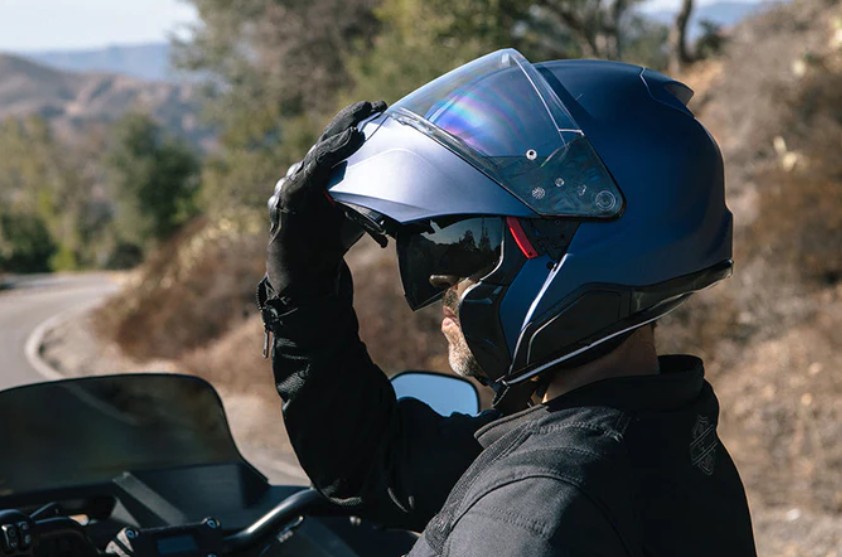
Ventilation is superb. Five intake vents and seven exhausts move air through the helmet, keeping you cool during tropical rides. The interior uses antibacterial fabric that wicks moisture and dries quickly. I particularly like the three‑position sunshield, which allows you to fine‑tune the drop‑down visor’s position. The outer shield is Pinlock‑ready, and the quick‑release mechanism makes swaps painless.
There’s more technology baked in: the RPHA 91 is Bluetooth ready for HJC’s Smart 21B or 50B units, and the intermediate‑oval shape fits a wide range of head types. The only drawback is the weight — it’s heavier than the carbon helmets mentioned here in this article. But the silver lining is that the extra mass gives a feeling of solidity, and at around US$600 it undercuts the premium carbon lids by hundreds. If your riding mix includes touring and commuting and you want premium comfort without remortgaging your house, the RPHA 91 deserves a look.
A premium DOT-rated modular helmet combining composite‑shell strength with a smooth flip‑front, quiet ride and adjustable sun visor for long-distance touring comfort.
- Composite PIM Evo shell offers superior impact protection
- Adjustable drop-down sun visor adapts to changing light
- Very quiet for a modular helmet—~96 dB at highway speeds
- Comfortable, plush liner with interchangeable cheek pads
- Slightly heavy compared to lighter modulars
- Chin bar lock can be finicky to operate with gloves
Read Our Review: For a head‑to‑head comparison with the Schuberth C5, see our C5 vs RPHA 91 showdown. I break down noise levels, ventilation and value across long tours.
Sedici Sistema 3 — Lightweight value
Not everyone can justify spending carbon money for a flip‑up lid. That’s where the Sedici Sistema 3 comes in. Built from a five‑layer composite of fiberglass, nylon and DuPont Kevlar, it tips the scales at roughly 3 lb 12 oz—about 3.7 lb in a medium size. That’s lighter than many modulars and some full‑faces, yet it doesn’t cost a fortune.
What makes the Sistema 3 special is how much comfort and convenience it packs at this weight. Sedici uses three shell sizes and multiple EPS liners to keep the helmet compact and well‑balanced. The 2 mm Pinlock‑ready face shield offers clear optics and snaps open with a positive feel, while intake and exhaust vents channel air across your scalp so you don’t cook in tropical heat. Inside, the 3D‑formed cheek pads and moisture‑wicking liner feel plush against your skin.
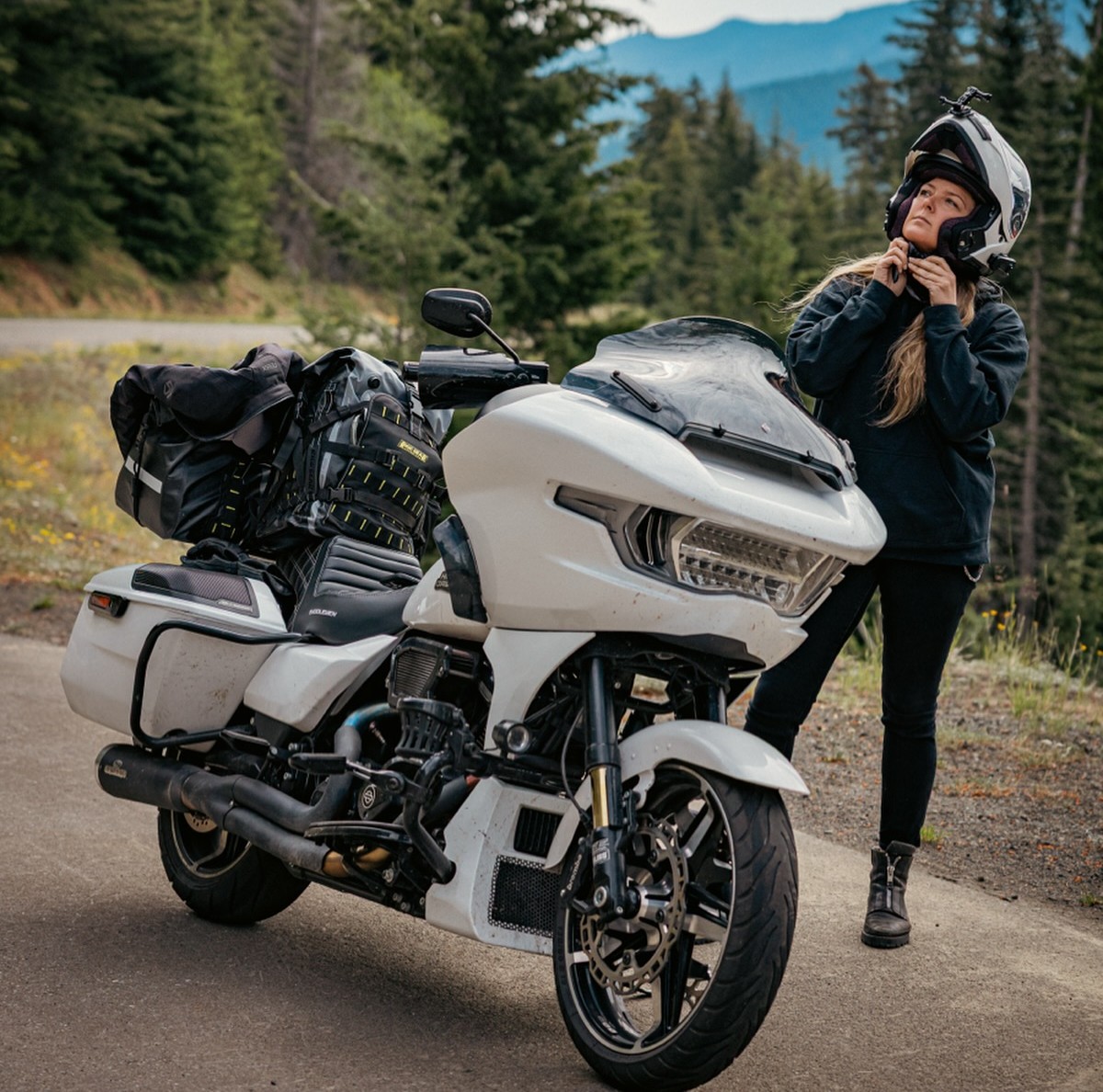
There are a few drawbacks. The composite shell isn’t as exotic as carbon, and the chin‑bar mechanism feels slightly heavier than the ultralight LS2. The silver lining is that Sedici offers two versions: the base Sistema 3 with speaker pockets, and the Parlare model that comes with a built‑in Sena communicator. Both versions are DOT and ECE 22.06 certified, and if you want to save weight without sacrificing comfort or safety, the Sistema 3 deserves a spot on your short list.
A lightweight modular helmet with features and build quality (like stainless steel visor components and seamless face shield gasket) of much more expensive lids.
- Strong & light fiberglass composite shell
- Close fit (5 EPS sizes and 3 shell sizes)
- DOT and ECE safety ratings
- Large speaker pockets
- Pinlock insert sold separately
Read Our Review: For more impressions on long‑term comfort and how the Sistema 3 compares to other budget modulars, check out our Best Modular Helmets roundup.
LS2 Advant X Carbon — The Transformer
You know those days where you leave home in crisp morning air and end up stuck in stop‑and‑go traffic under the afternoon sun? A traditional flip‑up helmet still feels stifling because the chin bar sits on top of your forehead when open, catching wind and making the helmet top heavy. LS2 solved this…
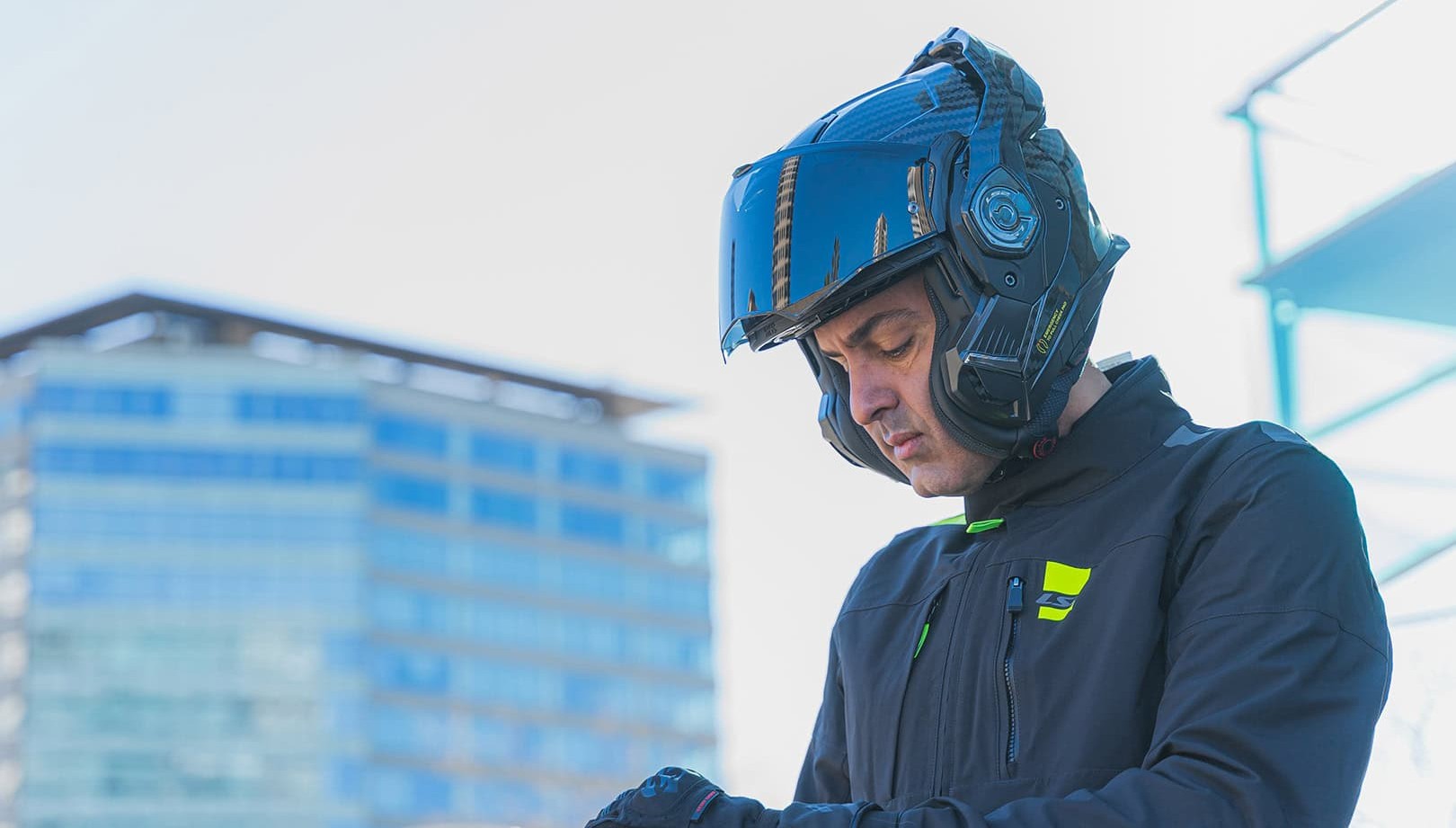
They designed a 180° rotating chin bar that locks in place behind the head so you can ride in open‑face mode without holding that weight up high or catching the wind like a sail. It’s like having two helmets in one.
The weight difference of the carbon version is obvious versus the standard lid. LS2’s 6K carbon‑fiber shell and chin bar trim the scale to about 1470 g (±50 g) — roughly 3.24 lb. That’s lighter than many full‑face helmets and far lighter than most modulars. Combined with a compact shell (two shell sizes cover XS through 3XL), the Advant X feels stable at speed and doesn’t fatigue your neck.
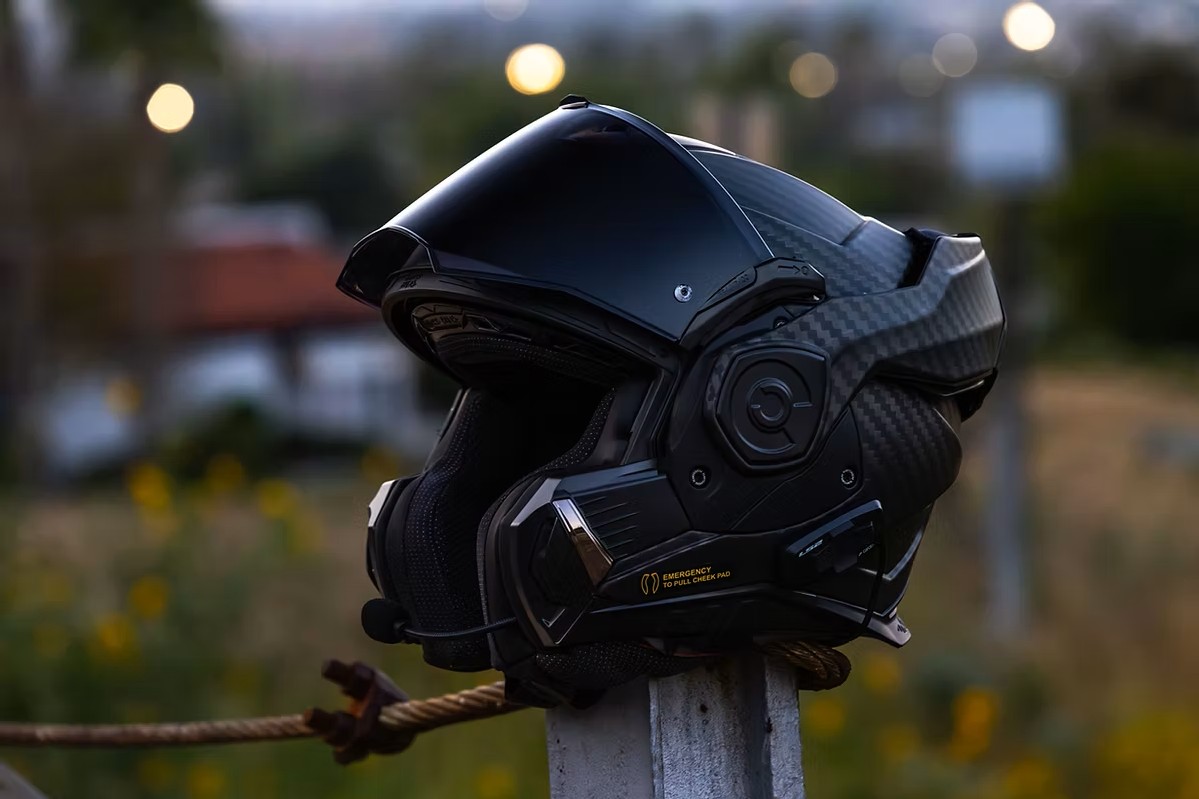
Comfort is equally impressive. The removable, moisture‑wicking liner uses 3D laser‑cut cheek pads to eliminate pressure points and channels air through adjustable vents. Even on a humid summer day, those vents flow plenty of air. The drop‑down sun visor is easy to operate with gloves, and the A‑class polycarbonate face shield provides clear optics and UV protection. LS2 even includes a Pinlock insert to eliminate fogging, which at this price is rare.
One of my only nitpicks is the micrometric buckle. It’s convenient but not as secure as a double‑D ring. The silver lining is that the quick‑release strap makes on‑off stops painless, and LS2’s emergency release cheek pads add peace of mind. If you love the classic double‑D rings, keep in mind it’s unfortunately rare on modulars – however, the Shoei Neotec 3 does have it!
A premium flip-back modular helmet made from full carbon with a 180° rotating chin bar, delivering both open-face freedom and full-face safety with top ventilation and sharp optics.
- Extremely lightweight carbon shell (~1470 g)
- 180° chin bar flips fully rearward for open-face mode
- Pinlock insert included with clear visor optics
- Comfortable fit with removable washable liners
- Visor seal may wear if left open often
- Slight wind noise at higher speeds
Read Our Review: We covered the LS2 Advant X in our modular helmet guide, highlighting its flip-back chin bar and the lightweight carbon option.
Sena Outrush R — Bluetooth convenience in a flip‑up package
With the Sena Outrush R, the conversation literally never stops. This modular uses a polycarbonate ABS shell and multi‑density EPS liner, keeping weight to around 3.85 lb. That’s a bit heavier than the ultralight carbon lids, but the trade‑off is a fully integrated Bluetooth system that requires no additional installation.
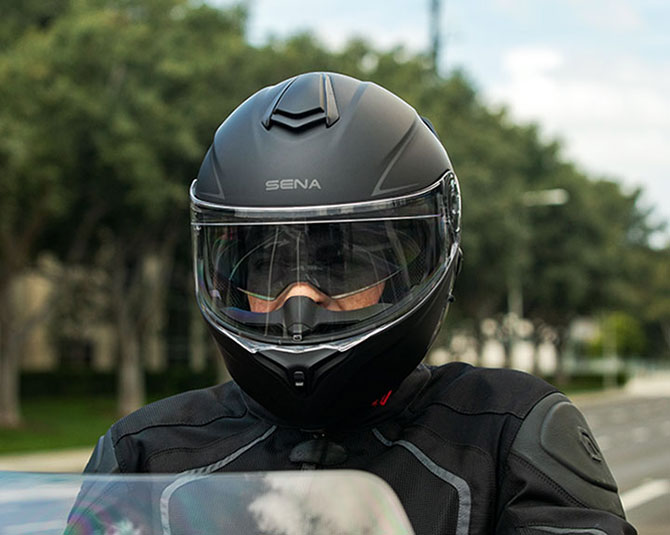
The built‑in Bluetooth 5.0 module offers up to 12 hours of talk time and lets you connect with up to four riders. The drop‑down sun visor operates smoothly, the face shield is scratch‑ and UV‑resistant, and top and chin vents plus a rear exhaust keep air flowing. A quick‑release micrometric buckle makes parking‑lot conversations effortless, and the helmet meets DOT safety standards.
The downside? The polycarbonate shell adds a few ounces, and you’re locked into Sena’s electronics. But the silver lining is that you get a tidy, clutter‑free setup that’s ready to pair with your phone right out of the box. For riders who prioritize communication and convenience over chasing the absolute lightest weight, the Outrush R hits a sweet spot.
A DOT-certified modular helmet with built-in Bluetooth 5.0, offering a quiet ride, integrated sun visor, and smooth flip-front usability for everyday touring.
- Built-in Bluetooth supports 4-rider intercom over ~0.6 mi
- Quiet performance for a modular lid at highway speeds
- Good airflow and ventilation keeps rider fresh
- Comfortable liner with washable padding and sun visor
- Padding compresses over time and may feel loose
- Bluetooth-only system lacks Mesh support for large groups
Read Our Review: We discuss how the Outrush R stacks up against other Bluetooth helmets in our Best Bluetooth Modular Helmet guide.
Scorpion EXO‑AT960 — Budget adventure modular
Adventure riders love the idea of a modular helmet but are often put off by price and weight. Enter the Scorpion EXO‑AT960. Its polycarbonate shell and multi‑density EPS keep costs down, while the flip‑up chin bar and removable peak give you two helmets in one. At around 4.09 lb in a medium size it’s heavier than the premium lids, but remember that most adventure lids weigh north of 3.8 lb anyway.
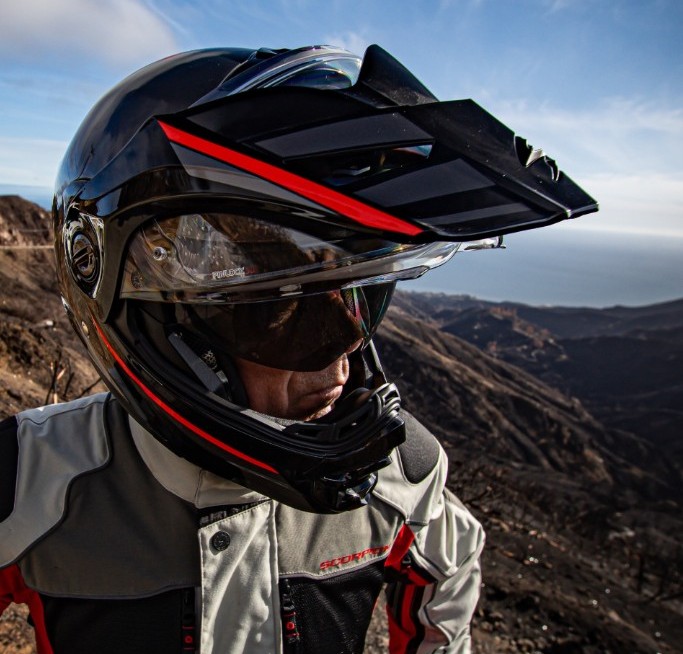
The Scorpion AT960 is built for versatility, whether you’re tackling muddy trails or logging highway miles. Its peak visor helps cut glare and deflect roost, yet can be removed quickly for long interstate stretches. Inside, KwikFit cheek pads accommodate eyeglasses, and the flip-up chin bar makes it easy to grab a drink or chat at a stop. The EXO-COM port supports Scorpion’s plug-and-play communicator, while the port cover can also fit third-party units.
A do-everything helmet, it's as comfortable on trails as the highway - though not as solid as premium competitors like the Arai XD-5. One of the rare modular ADV helmets, it's also it's DOT and ECE approved.
- Modular chinbar (rare in ADV helmet)
- Removable peak
- Decent airflow
- Drop down sun shade
- DOT and ECE 22‑06 approved
- Susceptible to visor leaks and fogging in heavy rain
- Sun peak vibrates noticeably at highway speeds
Yes, the AT960 is heavier and noisier than the carbon shells. The silver lining is value: at roughly $300, you get ECE 22.06 and DOT safety ratings and a five‑year warranty. If you crave featherweight performance, consider the LS2 or Klim Krios Pro. But for riders who want flip‑up convenience on a budget, the AT960 delivers more bang per buck than anything else.
Read Our Review: We pit the Scorpion AT960 against the premium Klim Krios Pro in our Klim Krios Pro vs Scorpion AT960 comparison. That article digs deeper into fit, ventilation and owner feedback.
HJC i91 — Value commuter
The HJC i91 is a solid starter helmet if you’re on a budget – you can read my full review on it here. It’s super comfortable, the chin bar is easy to operate and lifts with just a touch, and the cheek pads feel like pillows hugging your face. That’s more than I expected from a helmet in this price range, but that said it’s a pretty heavy helmet overall, weighing in at about 3.99 lb.
The comfort liner includes cutouts for eyeglasses, and there’s space to install HJC’s Smart 10B or 20B Bluetooth systems. However, I slapped a Cardo Spirit on the side.
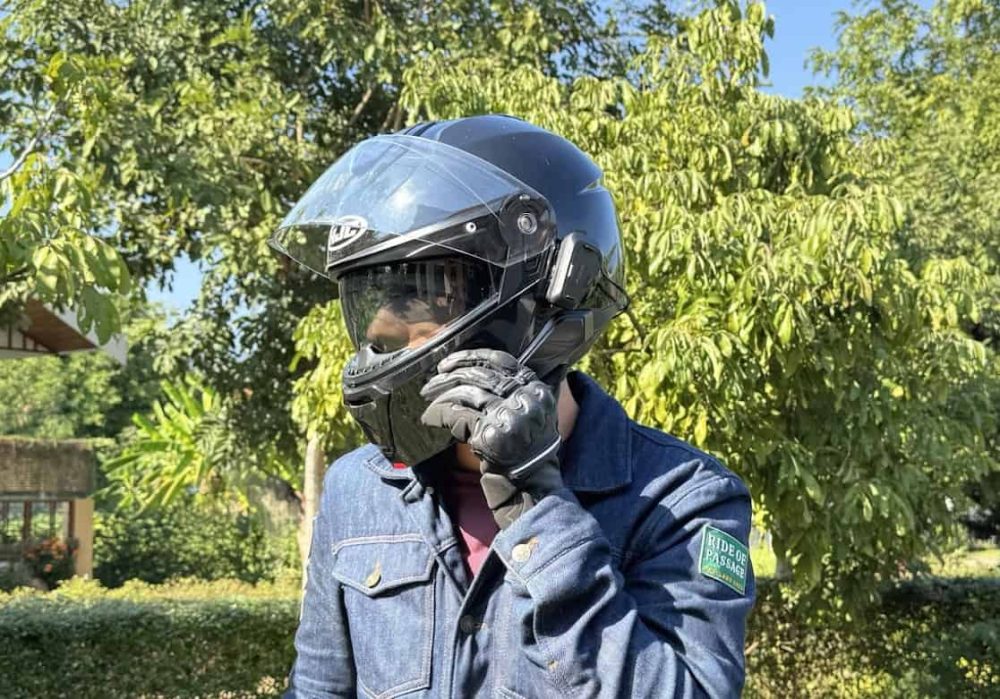
Downsides? Its basic polycarbonate shell saves on cost, but I’m sure it contributed to this helmet lacking any safety certifications beyond the basic DOT (which even tiny half helmets can certify for). The visor also feels flimsier than most helmets I’ve tried, even at this price range, and at high speeds it can leak some air. It doesn’t lock down like a vault like say my Shoei RF-SR.
If you have a bit more to spend, the HJC RPHA 91 offers a more refined experience. But for riders starting out or needing a second lid for passengers, the i91 is tough to beat.
A solid, comfortable, and affordable touring helmet with its fair share of flaws. But for the price and strong necks, it's good value. Read our full review here.
- Super comfortable liner and plush padding
- 3 shell sizes for better fit, look, and weight
- One of the best drop down sun visors in any helmet
- Heavy on the neck
- Flimsy visor that doesn't seal well
Comparison Table
| Helmet | Weight (approx.) | Shell / Key Features |
|---|---|---|
| Schuberth C5 Carbon | 3.21 lb (size L with comms) | Direct fiber carbon/glass shell; integrated speakers & antenna; advanced aerodynamics; 85 dB interior noise |
| HJC RPHA 91 | 3.85 lb | P.I.M. EVO carbon‑aramid hybrid shell; 5 intake & 7 exhaust vents; 3‑step sunshield; Bluetooth ready |
| Sedici Sistema 3 | ~3.7 lb (3 lb 12 oz) | Five‑layer fiberglass/nylon/Kevlar composite shell; triple shell sizes; 2 mm Pinlock‑ready shield; multiple vents & 3D interior; ECE 22.06 & DOT |
| LS2 Advant X Carbon | ~3.24 lb (1470 g) | 6K carbon shell & chin bar; 180° rotating chin bar; Pinlock included; drop‑down visor |
| Sena Outrush R | 3.85 lb | Polycarbonate shell; integrated Bluetooth 5.0 & speakers; drop‑down sun visor; scratch‑resistant shield; ventilation & quick‑release strap; DOT certified |
| Scorpion EXO‑AT960 | 4.09 lb | Polycarbonate shell; removable peak & flip‑up chin bar; eyeglass‑friendly cheek pads; EXO‑COM port |
| HJC i90 | 3.8 lb | Polycarbonate shell; cable‑actuated sun visor; Pinlock‑ready shield; DOT & ECE certified |
Buying Guide: Choosing the Right Lightweight Modular Helmet
Prioritize weight without compromising safety
Weight matters because it directly affects neck fatigue. A half‑pound might not seem like much until you’ve spent eight hours on the bike. Carbon‑fiber and composite shells save hundreds of grams — lids like the LS2 Advant X Carbon and Schuberth C5 Carbon come in well under 4 lb.
However, value‑oriented composites such as the Sedici Sistema 3 still keep weight around 3.7 lb, and polycarbonate lids like the Scorpion EXO‑AT960 and HJC i90 meet DOT and ECE standards while saving money.
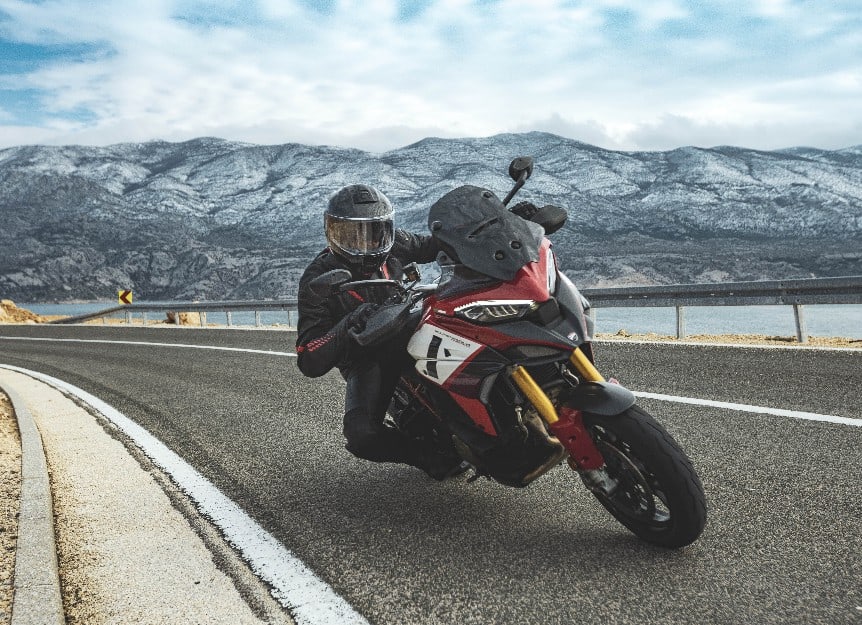
If you tour long distances or have neck issues, invest in a lighter carbon or composite helmet. For short commutes or occasional rides, a slightly heavier lid may be an acceptable compromise to save cash.
Consider your riding style
- Touring: Look for helmets with low noise, plush interiors and integrated comms. The Schuberth C5 Carbon is still the quietest in this roundup, while the Sedici Sistema 3 offers all‑day comfort, good ventilation and a Pinlock‑ready shield at a lower price.
- Sport or Sport‑Touring: You need stability at speed. The LS2 Advant X Carbon’s 6K carbon shell keeps weight down and the helmet planted; for ultimate quiet and stability, the Schuberth C5 Carbon’s aerodynamic shape excels.
- Urban/Commuting: Quick chin‑bar operation and ventilation take priority. The LS2’s 180° chin bar allows legal open‑face riding and is perfect for stop‑and‑go traffic. The HJC i90 offers great value with a smooth sun visor mechanism.
- Adventure/Dual‑Sport: A peak and glove‑friendly controls help off‑road. The Scorpion EXO‑AT960 provides modular convenience, a removable peak and decent ventilation at a budget price.
Don’t overlook fit and shape
Every helmet fits differently. Most of these lids are designed around an intermediate oval head shape, but shell sizing varies. The i90 and HJC helmets use just two shell sizes for multiple head sizes, which can result in a bulky look on small heads. LS2 and Sedici use two or three shells to maintain a slimmer profile. Try helmets on whenever possible and pay attention to pressure points; no amount of fancy features can fix an ill‑fitting lid.
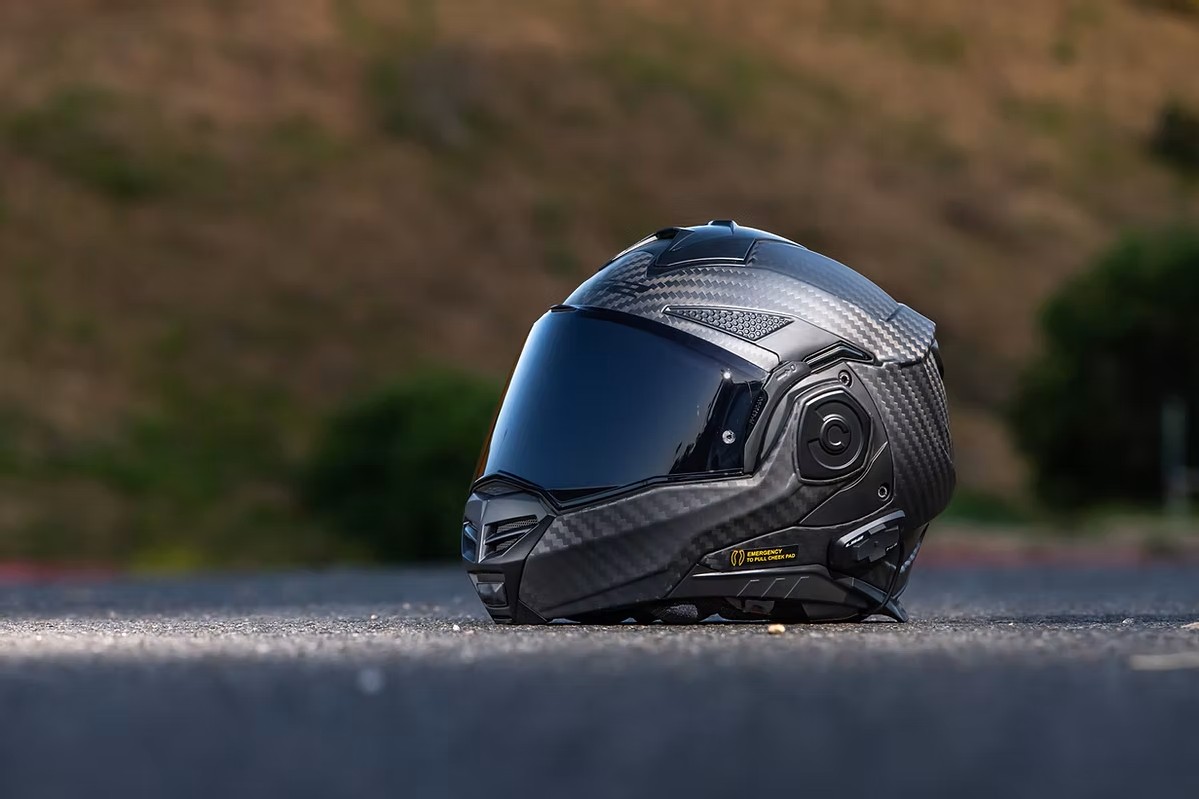
Ventilation and noise control
Adequate airflow keeps you comfortable and reduces visor fogging. Premium helmets like the RPHA 91 and Schuberth C5 have multiple intake and exhaust ports. The LS2 and Sedici helmets channel air efficiently through their shells, while budget polycarbonate lids can run warmer. Noise is influenced by helmet shape, vents and windscreen. Carbon shells typically dampen sound better; however, always wear earplugs on long rides.
Evaluate the extras
- Sun visors: Almost every modular here has an internal sunshield. Look for smooth operation and adequate coverage; HJC’s 3‑step visor and Sedici’s easy‑to‑use drop‑down visor are good examples.
- Comms integration: Integrated speakers and mic cut installation time. Schuberth includes SC2 wiring out of the box, Sedici offers a Parlare version with built‑in Sena comms, and Sena’s Outrush R arrives ready to pair with your phone. Scorpion’s EXO‑COM port and HJC’s Smart‑ready designs also simplify add‑ons.
- Legal open‑face use: The LS2 Advant X is dual‑homologated (ECE P/J), meaning you can ride with the chin bar flipped back and still be street legal.
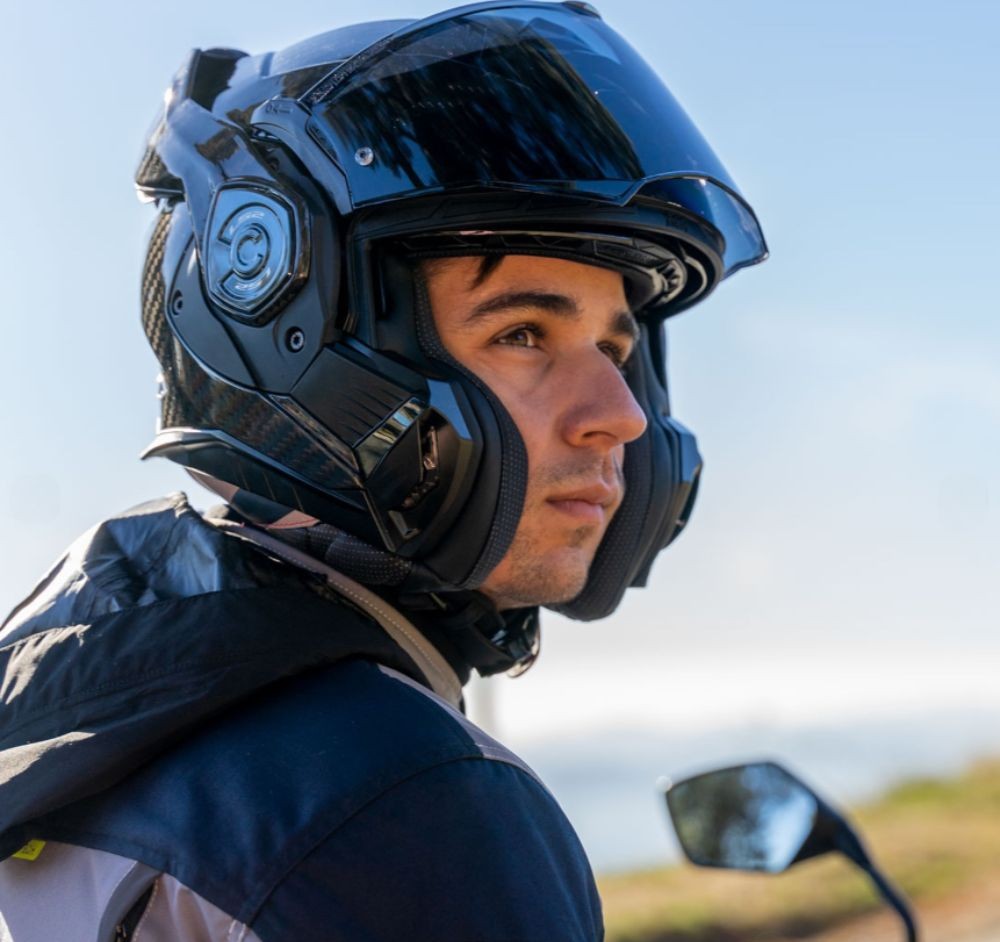
Not sure your comms unit will fit?
Sometimes the perfect helmet comes with a catch—it’s designed around a specific Bluetooth unit. That can make it tough if you prefer something different. With an adapter from Tubs Jackson, you can get a factory fit for any comms units on helmets you actually want to ride in.
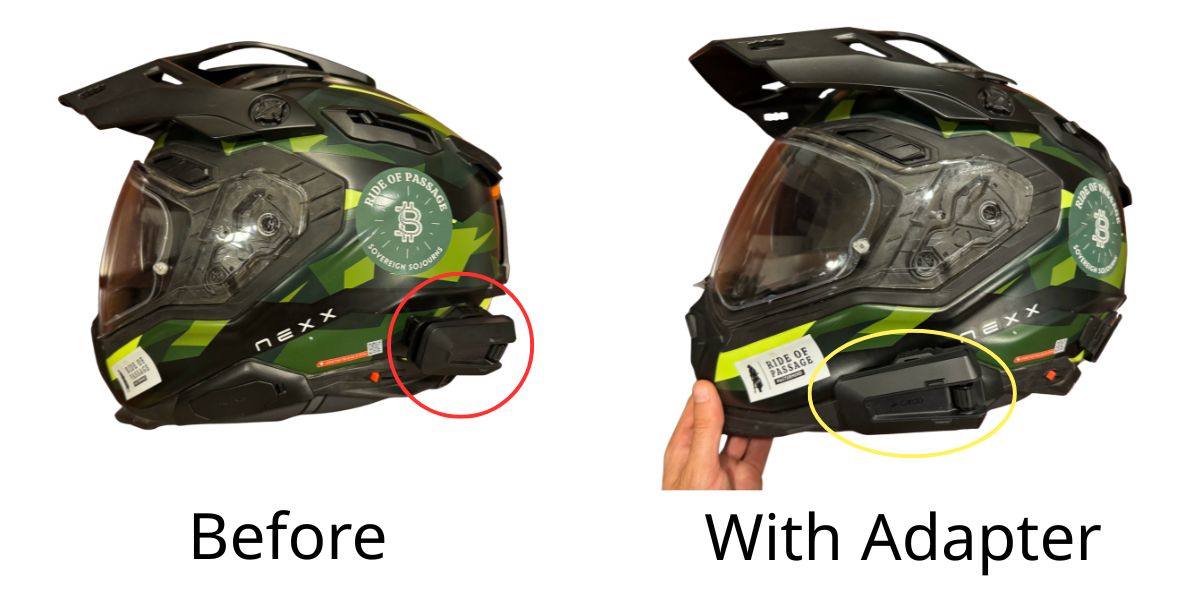
Tubs Jackson is a weird name, I know, but I have their adapter in my Nexx X.WED3 helmet and it’s rock solid. Much nicer than reaching way back to where I had the sticky mount before. I wish I’d thought of this idea.
Tip: Get FREE SHIPPING just by buying here or using code BETTERONTHEROAD at checkout.
Set your budget
Expect to spend between US$200 and US$1,500. Polycarbonate helmets like the i90 and EXO‑AT960 keep costs low and still meet safety standards. Mid‑range composite helmets like the RPHA 91 and Sedici Sistema 3 offer a balance of weight and features. Top‑shelf carbon lids such as the LS2 Advant X and Schuberth C5 Carbon deliver the lightest weight and refined comfort but command premium prices. Helmets with integrated electronics like the Sena Outrush R add convenience for a modest price increase.
Final Thoughts
Choosing the lightest modular helmet isn’t just about numbers on a scale. It’s about finding a helmet that matches your riding style, budget and comfort needs. After thousands of miles and countless helmet swaps, I’ve found that a few extra dollars spent on weight savings can make all the difference on long rides.
Whether you’re chasing carbon‑fiber exotica or sticking to a budget, there’s a lightweight modular here that will let you flip up the chin bar with one hand and still feel refreshed at the end of the day.
Ride safe, and may your neck never ache from a heavy lid again.
Related

Carbon Fiber Modular Helmets: Ultimate Flip-Up Lids
Discover carbon fiber modular helmets that deliver flip-up convenience, lightweight strength, and serious protection for every ride.

